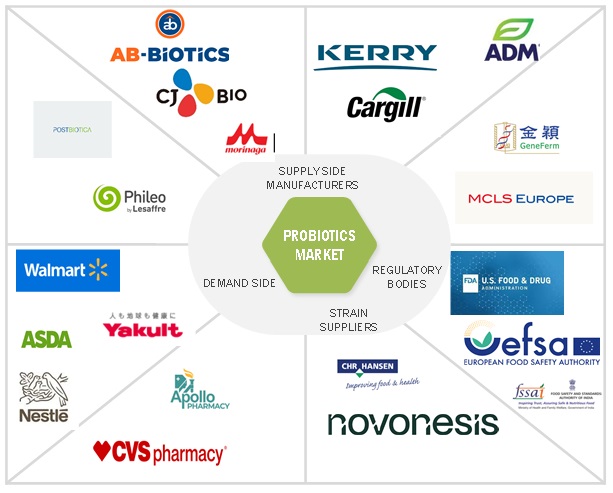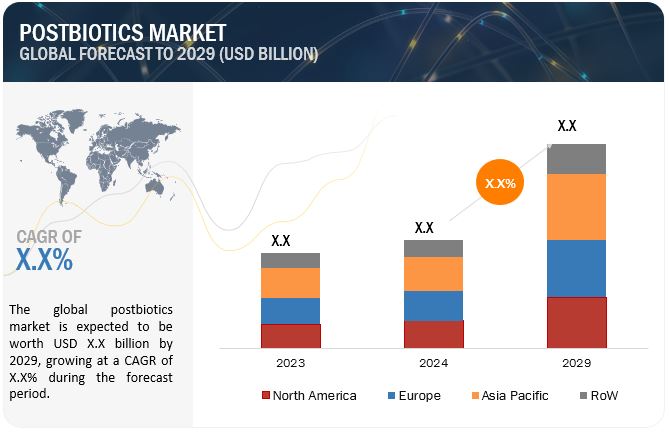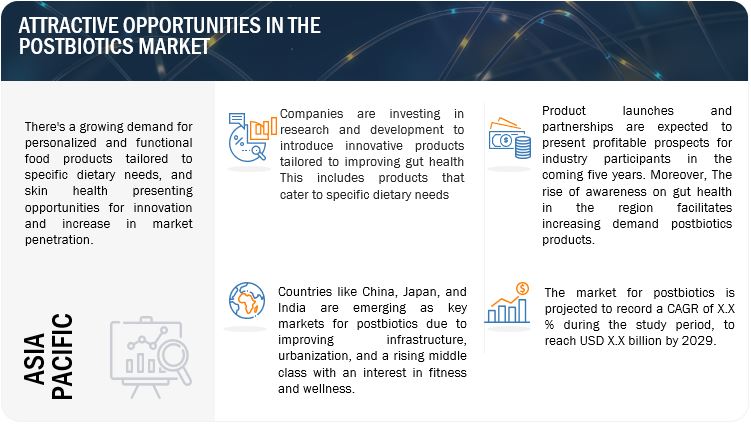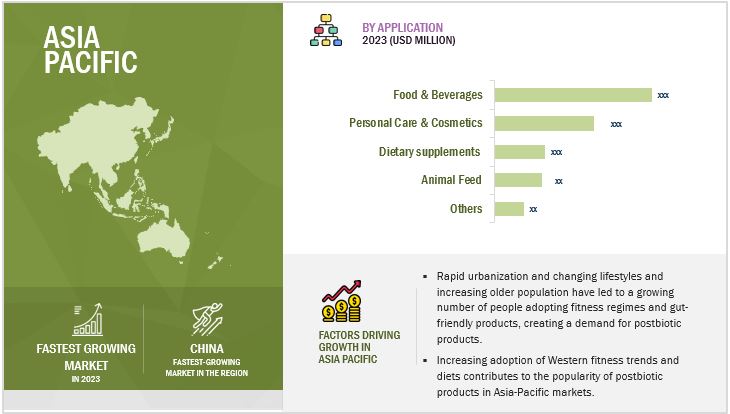Postbiotics Market by Source (Bacteria, Yeast), Form (Liquid, Dry), Application (Functional Food & Beverages, Dietary Supplements, Animal Feed, Personal Care & Cosmetics), Function (Gut Health, Immune System Enhancement, Inflammation Reduction, Skin Health, Metabolic Health, Weight Management) - Global Forecast to 2029
The global postbiotics market is on a trajectory of significant expansion, with an estimated value projected to reach USD XX billion by 2029 from the 2024 valuation of USD XX billion, displaying a promising Compound Annual Growth Rate (CAGR) of 6.0%. As research studies continue to underline the benefits of postbiotics prominently in improving gut and digestive health, consumers are increasingly incorporating postbiotics into their daily routines. The global consumer perception toward food products is moving from products providing basic nutrition towards the products that offer health benefits, such as functional foods. In the recent years, several functional foods have been developed, including postbiotics. These products have changed the approach of various food processors from considering food only as a source of energy and nutrition to biologically active food components that confer benefits on human health.
The growing awareness related to health and nutrition products among consumers in North America and Europe drives the market for postbiotics. Personal well-being is a major factor that influences the consumption of natural ingredient products, prominently for postbiotics. Consumers have realized that adding postbiotics to their regular diet offers health benefits such as improved intestinal health, low-calorie intake, increased immunity, and boosted calcium absorption, thereby driving the market for postbiotic products. Moreover, growing research and development in the production and formulation of postbiotics are also playing a crucial role in the market’s upward trajectory.
To know about the assumptions considered for the study, Request for Free Sample Report
Market Dynamics
Increasing consumer awareness of gut health
According to a research study published by Cargill in 2021, 75% of wellness product buyers perceive that their overall health is affected by the gut microbiome. Recent research studies has indicated several health benefits that are associated with a balanced gut microbiota: digestion, immunity, and even benefits associated with mental health. Postbiotics are important in lending to these health benefits because they modulate the activity of the gut microbiota without involving live bacteria. With endorsements from healthcare professionals and influencers, awareness of the importance of gut health has permeated mainstream media and consumer consciousness. This has led to greater acceptance and adoption of postbiotics as an effective and convenient way to support gut health.
This trend spans across various demographics, encompassing young adults prioritizing their health and older populations managing age-related health concerns. The increasing focus on holistic health and wellness drives consumers towards products that provide targeted health benefits, like enhancing gut health, which is directly associated with postboitics. Moreover, rising disposable incomes and increased expenditures on health products enable consumers to invest more in postbiotics, thereby further elevating their demand.
Restraints:Inconsistency in regulatory norms governing postbiotics
The regulatory landscape for postbiotics is complex and varies across regions. The lack of standardized regulations can pose challenges for manufacturers and hinder market growth. Countries such as South Korea, China, Thailand, the Philippines, Singapore, Vietnam, and Taiwan have now begun commercializing postbiotics in Asia Pacific. The regulators are updating guidelines, and the firms involved in manufacturing postbiotics have also come to the forefront to get product registrations. The Association of Southeast Asian Nations (ASEAN), on the other hand, has been harmonizing technical standards for traditional medicines and health supplements since 2004. This regional effort at the achievement of standardization will bear down on the postbiotics industry in terms of the health claims allowed for postbiotic products. Addressing the issue of quantification methods, essential for advancing research and providing regulatory bodies with the necessary tools to regulate non-viable microbes, remains an ongoing process.
In the European Union, postbiotics, like probiotics and prebiotics, are subject to both novel food regulation and health claim regulation. The European Food Safety Authority (EFSA) guidance document for the safety assessment of live microbes is challenging and lacks clear guidelines. These regulatory complexities can create barriers for manufacturers and marketers, complicating the process of introducing postbiotics products to the market.
Opportunities: Continuous Demand for Solutions related to Skin and Sleep Issues
According to a research study by CJ Bio in 2023, sleep and skin health rank as 2nd and 3rd, respectively, in the quest for new solutions to various health issues in US. These are issues that often develop during stages of life. For instance, many menopausal women experience sleeplessness, facial blushing of the skin, and drying of the skin from the improper levels of their hormones. It have created the market for dietary supplements developed for the needs of addressing these skin development needs in menopausal women. Therefore, although skin and sleep health issues are very common, they are more prevalent in some demographic groups, so solutions should be personalized for certain groups. With growing concerns about sleep and skin health, the demand for solutions focusing on these issues is witnessing an increasing demand in recent years. This heightened demand has opened up huge investment opportunities for postbiotic manufacturers as they are exploring postbiotics as a solution to alleviate sleep and skin health issues. For instance, CJ Cheiljedang Corp. IN 2024, has launched BiomeNrich™ postbiotic solutions to address a range of health concerns including skin health.
Challenges: Lack of consumer acceptance due to definite regulatory structure
The key challenge for postbiotics is gaining market acceptance among consumers, many of whom struggle to differentiate between probiotics and postbiotics. This confusion is not surprising, given that, unlike probiotics, there is no clear regulatory framework for postbiotics in many countries. Additionally, there is a lack of widely accepted consensus on the definition of a postbiotic. The probiotics market is well-established, well-recognized, and deeply trusted by consumers. Postbiotics, therefore, must compete for this market share with well-known products. Hence, in order for postbiotic products to be successful, they have to clearly differentiate their benefit and application outstandingly from those of probiotics and prebiotics, respectively, which is so cumbersome in the handling of claims in the absence of a good regulatory framework.
Effective communication strategies, such as informative campaigns, clear labeling, and endorsements from health professionals, are essential to bridge the knowledge gap and drive adoption of probiotics.
Market Ecosystem

Powder Form Is Dominating The Market Growth During The Study Period.
The dominance of powdered postbiotics in the market during the study period can be attributed to their versatility, stability, and customization options. Powdered postbiotics can be easily incorporated into a wide range of food and beverage products without significant alteration in taste or texture. This versatility appeals to manufacturers looking to diversify product offerings. The powder forms, have longer and are more stable than in their liquid or perishable forms. This guarantees product effectiveness and consumer confidence over extended periods. This enables the manufacturers to benefit from reduced storage and transportation costs due to the stable nature of powdered postbiotics.
In addition, powdered postbiotics allow for precise formulation adjustments, including varying concentrations of active ingredients or combinations with other functional additives. Powdered postbiotics allow to adjust the formula with a high degree of accuracy of active ingredients in respect of variability and variability of its concentration, in case you decide to add another functional additive. With growing gut health awareness among consumers and increasing demand for functional foods and supplements, continued innovation in powder formulations will very likely be necessary for manufacturers to maintain and grow leading positions.
Personal Care & Cosmetics Emerge As The Fast-Growing Segment In The Postbiotics Market.
Postbiotics are derived from beneficial microbial metabolites or components, making them a natural and safe alternative for personal care and cosmetics formulations. Consumers increasingly prefer products with natural ingredients, driving demand for postbiotic-based skincare solutions. Various research studies have demonstrated postbiotic properties that can improve skin barrier function, enhance hydration, reduce inflammation, and promote skin renewal. These benefits appeal to consumers seeking effective solutions for various skin concerns, including sensitive skin, acne, and aging.
Cosmetic and personal care companies are actively engaging in innovations with postbiotics for the manufacture of new formulae targeting specific skin concerns. Among these activities are serums, creams, masks, and cleansers enriched with postbiotics to demonstrate desired specified benefits for a variety of skin types and conditions. The growing millennial population coupled with increasing awareness on skin health is augmenting the use of postbiotics in personal care and cosmetics products.
Asia Pacific Is The Fastest-Growing Market For Postbiotics Among The Regions.
The Asia Pacific postbiotics market is growing at an exponential rate during the forecast period. This growth emanates directly from demographic shifts, economic dynamics, and changes in people's lifestyles in this region. The aging population in this region is one of the chief catalysts that drive this growth. The demand for such products is on the rise as the elderly population in countries such as Japan, China, and South Korea with a growing awareness of gut health. of bone and cardiovascular health.
According to a September 2022 article in The Japan Times, more than 15% of Japan's population is aged 75 and above. This demographic shift reflects a substantial increase in the number of individuals seeking to address age-related health concerns, facilitating the sales of postbiotic products. Furthermore Increasing consumer interest in nutritional and health products due to is expected to expand opportunities for growth and diversification within the postbiotics industry in the region.
Key Market Players
The key players in the market are Archer Daniel Midland (US), Cargill, Incorporated (US), DSM (US), Kerry Group PLC (US), Phileo by Lesaffre (France), Postbiotica S.r.l (Italy), MCLS EUROPE B.V (Netherlands), AB-Biotics, SA (Spain), Geneferm Biotechnology Co., Ltd (Taiwan) and Morinaga Milk Industry Co., Ltd. (Japan)
Recent Developments
- In July 2024, Cargill entered into an exclusive distribution agreement with Brenntag for its EpiCor postbiotic ingredient, covering a wide geographic area across Europe. This is anticipated to address both existing customers' current needs and new product requirements, potentially leading to new product development initiatives."
- In February 2024, Kerry Group launched Plenibiotic (Lactobacillus casei subsp. 327), a postbiotic derived from rice, designed for human and pet supplement formats. focuses on the gut-skin connection, in line with increasing consumer awareness of the relationship between gut health and overall well-being.
- In April 2023, ADM has inaugurated a new production facility in Valencia, Spain. The Chicago-based company announced an investment exceeding USD 30 million in the plant, aimed at satisfying growing global demand for probiotics, postbiotics, and related products promoting health and well-being across the United States, Asia-Pacific, and Europe.
Frequently Asked Questions (FAQ):
What is the current size of the postbiotics market?
The postbiotics market is estimated at USD XX billion in 2024 and is projected to reach USD XX billion by 2029, at a CAGR of 6.0% from 2024 to 2029.
Which are the key players in the market, and how intense is the competition?
The key players in the postbiotics market are Archer Daniel Midland (US), Cargill, Incorporated (US), DSM (US), Kerry Group PLC (US), Phileo by Lesaffre (France), Postbiotica S.r.l (Italy), MCLS EUROPE B.V (Netherlands), AB-Biotics, SA (Spain), Geneferm Biotechnology Co., Ltd (Taiwan) and Morinaga Milk Industry Co., Ltd. (Japan)
The postbiotics market is anticipated to witness increased scope for growth. The market is seeing an increase in the number of product launches, partnerships, joint ventures, acquisitions, and new expansions. Moreover, the companies involved in manufacturing postbiotics are investing a considerable proportion of their revenues in research and development activities.
Which region is projected to account for the largest share of the postbiotics market?
The European market is expected to account for the largest share during the study period. The increased health awareness among European consumers is propelling the demand for postbiotics. In addition, there is increasing research and development for postbiotics and their application in various regional sectors.
What kind of information is provided in the company profile section?
The company profiles mentioned above offer valuable information such as a comprehensive business overview, including details on the company's various business segments, financial performance, geographical reach, revenue composition, and the breakdown of their business revenue. Additionally, these profiles offer insights into the company's product offerings, significant milestones, and expert analyst perspectives to further explain the company's potential.
What are the factors driving the postbiotics market?
The postbiotics market is driven by several key factors, including increasing awareness of gut health, and growing demand for functional foods, coupled with the growing urbanization and rising disposable incomes, has led to increased spending on postbiotics products. Furthermore, increasing technical research proving the efficacy of postbiotics for gut and skin health is propelling the market’s growth. .
To speak to our analyst for a discussion on the above findings, click Speak to Analyst



















Growth opportunities and latent adjacency in Postbiotics Market